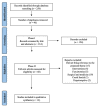Potential Nociceptive Role of the Thoracolumbar Fascia: A Scope Review Involving In Vivo and Ex Vivo Studies
- PMID: 34640360
- PMCID: PMC8509394
- DOI: 10.3390/jcm10194342
Potential Nociceptive Role of the Thoracolumbar Fascia: A Scope Review Involving In Vivo and Ex Vivo Studies
Abstract
Nociceptive innervation of the thoracolumbar fascia (TLF) has been investigated over the past few decades; however, these studies have not been compiled or collectively appraised. The purpose of this scoping review was to assess current knowledge regarding nociceptive innervation of the TLF to better inform future mechanistic and clinical TLF research targeting lower back pain (LBP) treatment. PubMed, ScienceDirect, Cochrane, and Embase databases were searched in January 2021 using relevant descriptors encompassing fascia and pain. Eligible studies satisfied the following: (a) published in English; (b) preclinical and clinical (in vivo and ex vivo) studies; (c) original data; (d) included quantification of at least one TLF nociceptive component. Two-phase screening procedures were conducted by a pair of independent reviewers, after which data were extracted and summarized from eligible studies. The search resulted in 257 articles of which 10 met the inclusion criteria. Studies showed histological evidence of nociceptive nerve fibers terminating in lower back fascia, suggesting a TLF contribution to LBP. Noxious chemical injection or electrical stimulation into fascia resulted in longer pain duration and higher pain intensities than injections into subcutaneous tissue or muscle. Pre-clinical and clinical research provides histological and functional evidence of nociceptive innervation of TLF. Additional knowledge of fascial neurological components could impact LBP treatment.
Keywords: ex vivo; fascia; in vivo; innervation; lower back pain; nociceptor; pain; scoping review; thoracolumbar fascia.
Conflict of interest statement
The authors declare no conflict of interest.
Figures
Similar articles
-
Innervation changes induced by inflammation of the rat thoracolumbar fascia.Neuroscience. 2015 Aug 6;300:351-9. doi: 10.1016/j.neuroscience.2015.05.034. Epub 2015 May 21. Neuroscience. 2015. PMID: 26003735
-
Sensory innervation of the thoracolumbar fascia in rats and humans.Neuroscience. 2011 Oct 27;194:302-8. doi: 10.1016/j.neuroscience.2011.07.066. Epub 2011 Aug 2. Neuroscience. 2011. PMID: 21839150
-
Innervation of the thoracolumbar fascia.Eur J Transl Myol. 2019 Sep 6;29(3):8297. doi: 10.4081/ejtm.2019.8297. eCollection 2019 Aug 2. Eur J Transl Myol. 2019. PMID: 31579474 Free PMC article.
-
The Neurophysiological Impact of Experimentally-Induced Pain on Direct Muscle Spindle Afferent Response: A Scoping Review.Front Cell Neurosci. 2021 Feb 19;15:649529. doi: 10.3389/fncel.2021.649529. eCollection 2021. Front Cell Neurosci. 2021. PMID: 33679333 Free PMC article.
-
Ultrasound Imaging of Thoracolumbar Fascia: A Systematic Review.Medicina (Kaunas). 2024 Jul 3;60(7):1090. doi: 10.3390/medicina60071090. Medicina (Kaunas). 2024. PMID: 39064519 Free PMC article.
Cited by
-
Fetal Fascial Reinforcement Development: From "a White Tablet" to a Sculpted Precise Organization by Movement.Biology (Basel). 2022 May 11;11(5):735. doi: 10.3390/biology11050735. Biology (Basel). 2022. PMID: 35625463 Free PMC article.
-
"Long COVID-19" and viral "fibromyalgia-ness": Suggesting a mechanistic role for fascial myofibroblasts (Nineveh, the shadow is in the fascia).Front Med (Lausanne). 2023 Apr 6;10:952278. doi: 10.3389/fmed.2023.952278. eCollection 2023. Front Med (Lausanne). 2023. PMID: 37089610 Free PMC article.
-
Dose-Dependent Pain and Pain Radiation after Chemical Stimulation of the Thoracolumbar Fascia and Multifidus Muscle: A Single-Blinded, Cross-Over Study Revealing a Higher Impact of Fascia Stimulation.Life (Basel). 2022 Feb 25;12(3):340. doi: 10.3390/life12030340. Life (Basel). 2022. PMID: 35330091 Free PMC article.
-
Effects of a Myofascial Technique on the Stiffness and Thickness of the Thoracolumbar Fascia and Lumbar Erector Spinae Muscles in Adults with Chronic Low Back Pain: A Randomized before-and-after Experimental Study.Bioengineering (Basel). 2023 Mar 6;10(3):332. doi: 10.3390/bioengineering10030332. Bioengineering (Basel). 2023. PMID: 36978723 Free PMC article.
-
An Emerging Perspective on the Role of Fascia in Complex Regional Pain Syndrome: A Narrative Review.Int J Mol Sci. 2025 Mar 20;26(6):2826. doi: 10.3390/ijms26062826. Int J Mol Sci. 2025. PMID: 40141468 Free PMC article. Review.
References
-
- Meyer R.A., Ringkamp M., Campbell J.N., Raja S.N. Peripheral mechanisms of cutaneous nociception. In: McMahon S.B., Koltzenburg M., editors. Wall and Melzack’s Textbook of Pain. Elsevier; Philadelphia, PA, USA: 2008. pp. 3–34.
-
- Basbaum A.I., Jessell T. The Perception of Pain. In: Kandel E.R., Schwartz J., Jessell T., editors. Principles of Neuroscience. Appleton and Lange; New York, NY, USA: 2000. pp. 472–491.
Publication types
LinkOut - more resources
Full Text Sources
Miscellaneous


